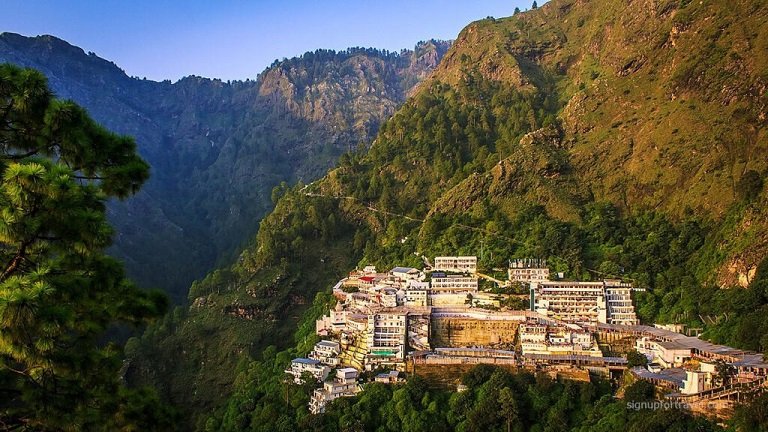Nestled amid the majestic Trikuta Mountains in the northern Indian state of Jammu and Kashmir, the sacred abode of Vaishno Devi beckons pilgrims and seekers alike. This sacred shrine, dedicated to Goddess Vaishno Devi, is not just a physical destination but a spiritual journey that captivates the hearts of millions. Join us as we embark on the pilgrimage to Vaishno Devi, discovering the divine tranquility that awaits those who tread the path.
-
The Call of the Divine: The journey to Vaishno Devi begins with a call from the divine, drawing pilgrims to the foothills of the Trikuta Mountains. The serene surroundings and the anticipation of the spiritual voyage create an aura of reverence.
-
The Holy Trek: As pilgrims set foot on the mountainous trail, a sense of both physical and spiritual elevation takes hold. The trek, approximately 12 kilometers in length, winds through lush landscapes, echoing with the chants of “Jai Mata Di.” The arduous climb is a metaphorical ascent towards self-discovery and spiritual awakening.
-
Three Sacred Caves: Vaishno Devi, also known as Mata Rani, resides in three sacred caves symbolizing the three divine forms – Mahakali, Mahalakshmi, and Mahasaraswati. Pilgrims traverse through these caves, each holding its own significance, and feel the divine energy that permeates the air.
-
The Divine Darshan: The ultimate reward of the pilgrimage is the darshan (sacred glimpse) of the Goddess in her natural rock form. The moment of standing in front of the sacred Pind is transformative, instilling a profound sense of peace and bliss.
-
Spiritual Reflection: Vaishno Devi’s journey is not just a physical one but a pilgrimage of the soul. Pilgrims often find moments of quiet reflection during the trek, contemplating life’s journey and seeking answers to spiritual queries.
-
Bhairon Temple: Adjacent to the Vaishno Devi shrine is the Bhairon Temple, dedicated to Bhairon Nath, a devotee who sought forgiveness from the Goddess. The visit to this temple completes the pilgrimage and signifies the triumph of devotion over adversity.
-
Vaishno Devi Arti: The resonating sound of the evening Arti at Vaishno Devi is a culmination of devotion, creating a spiritual symphony that echoes through the mountains. The flickering lamps, rhythmic chants, and the breathtaking view create an ethereal atmosphere.
-
Community Spirit: The pilgrimage to Vaishno Devi fosters a sense of community and shared spirituality. Pilgrims, regardless of background, come together in a spirit of harmony and devotion, exemplifying the universal appeal of the divine.
-
Divine Souvenirs: The journey to Vaishno Devi often involves acquiring souvenirs, not just as material mementos but as symbols of the divine connection forged during the pilgrimage. These tokens become cherished reminders of the transformative journey.
-
Return to the World: As pilgrims descend from the Trikuta Mountains, they carry the divine energy and tranquility within. The return journey becomes a transition from the sacred to the secular, armed with newfound strength and spiritual insights.
Vaishno Devi, with its challenging yet spiritually enriching trek, stands as a testament to the enduring power of faith and devotion. The journey to Vaishno Devi is not just a physical sojourn; it is a pilgrimage that leads to the heart of divine tranquility. For those seeking a transformative spiritual experience, the sacred abode of Vaishno Devi remains an eternal beacon, guiding pilgrims toward a deeper understanding of themselves and the divine.






